Overview
The article presents ten compelling benefits of thermoelectric fridges specifically tailored for engineers. These advantages include:
- Compact design
- Low maintenance requirements
- Energy efficiency
- Versatility across a range of applications
Each of these points is substantiated by evidence demonstrating:
- Reduced operational costs
- Minimal environmental impact
- Notable increase in market demand
Consequently, thermoelectric fridges emerge as a highly attractive solution for contemporary engineering challenges.
Introduction
Thermoelectric fridges are revolutionizing the approach engineers take to temperature management, offering a compelling blend of efficiency, reliability, and innovation. These advanced cooling systems, which harness the Peltier effect, present a unique opportunity for engineers to enhance performance across various applications, ranging from medical devices to consumer electronics. As the demand for sustainable and cost-effective solutions escalates, the question arises: can thermoelectric technology genuinely meet the diverse needs of modern engineering while effectively overcoming the traditional challenges of refrigeration?
Gagner-Toomey Associates: Pioneering Innovative Cooling Solutions for Thermoelectric Fridges
Gagner-Toomey Associates stands at the forefront of innovative temperature control solutions, especially in thermoelectric fridge technology. By collaborating with a diverse array of manufacturers, the company provides engineers with access to advanced temperature management solutions that significantly enhance performance and efficiency.
Thermoelectric fridges, which leverage the Peltier effect, present numerous advantages, including:
- A compact design
- Reliability
- The capacity to function without moving parts
This results in reduced maintenance requirements and extended lifespans. Such systems are particularly beneficial in applications that demand precise temperature regulation, such as medical equipment and electronic device refrigeration.
Recent statistics indicate a growing acceptance of energy-efficient refrigerators within , driven by their environmentally friendly operation and ability to maintain consistent temperatures with minimal energy consumption. Successful implementations of temperature-regulating systems have been observed across various industries, showcasing their versatility and effectiveness.
Gagner-Toomey Associates remains committed to addressing the complex challenges faced by engineers, ensuring they have access to the latest innovations in energy conversion technology. As the demand for cutting-edge refrigeration methods continues to rise, Gagner-Toomey Associates is poised to lead the advancement and implementation of refrigeration technologies.
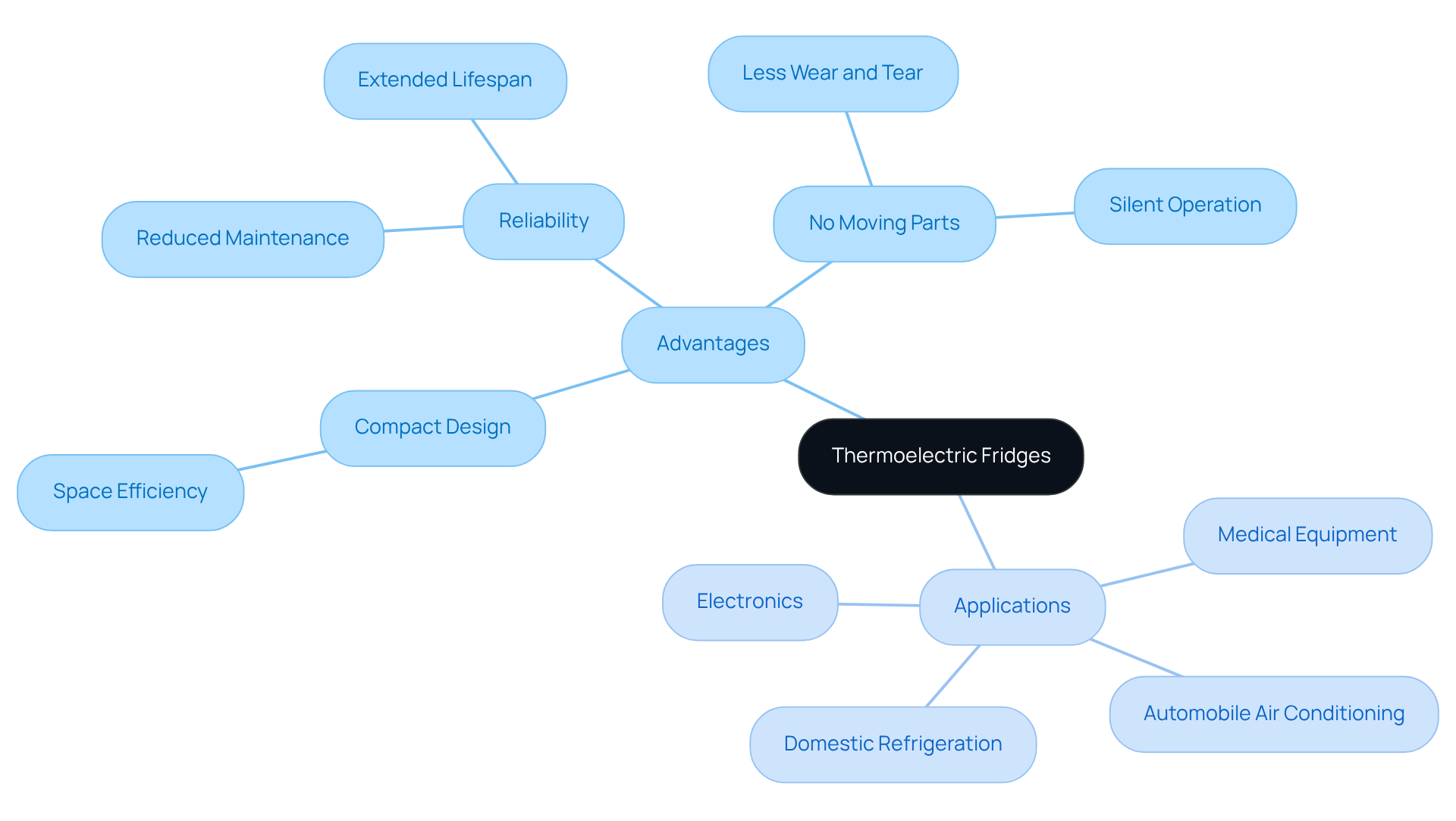
Energy Efficiency: How Thermoelectric Fridges Reduce Power Consumption
The Peltier effect is leveraged by thermoelectric fridges to create a temperature differential, allowing for cooling without the need for traditional refrigerants. This cutting-edge technology, known as the thermoelectric fridge, has the potential to decrease power consumption by as much as 50% in comparison to conventional refrigeration methods, rendering it a compelling choice for engineers in pursuit of .
A recent case study reveals that the integration of cooling technologies has led to significant reductions in operational costs and a smaller carbon footprint across various applications. Engineers have observed that the adoption of these systems not only addresses the demand for sustainable energy practices but also resonates with the increasing focus on lowering energy consumption within the electronics sector.
As underscored by industry leaders, transitioning to energy-efficient technologies, such as thermodynamic refrigerators, is critical for addressing the ongoing energy crises and promoting a more sustainable future.
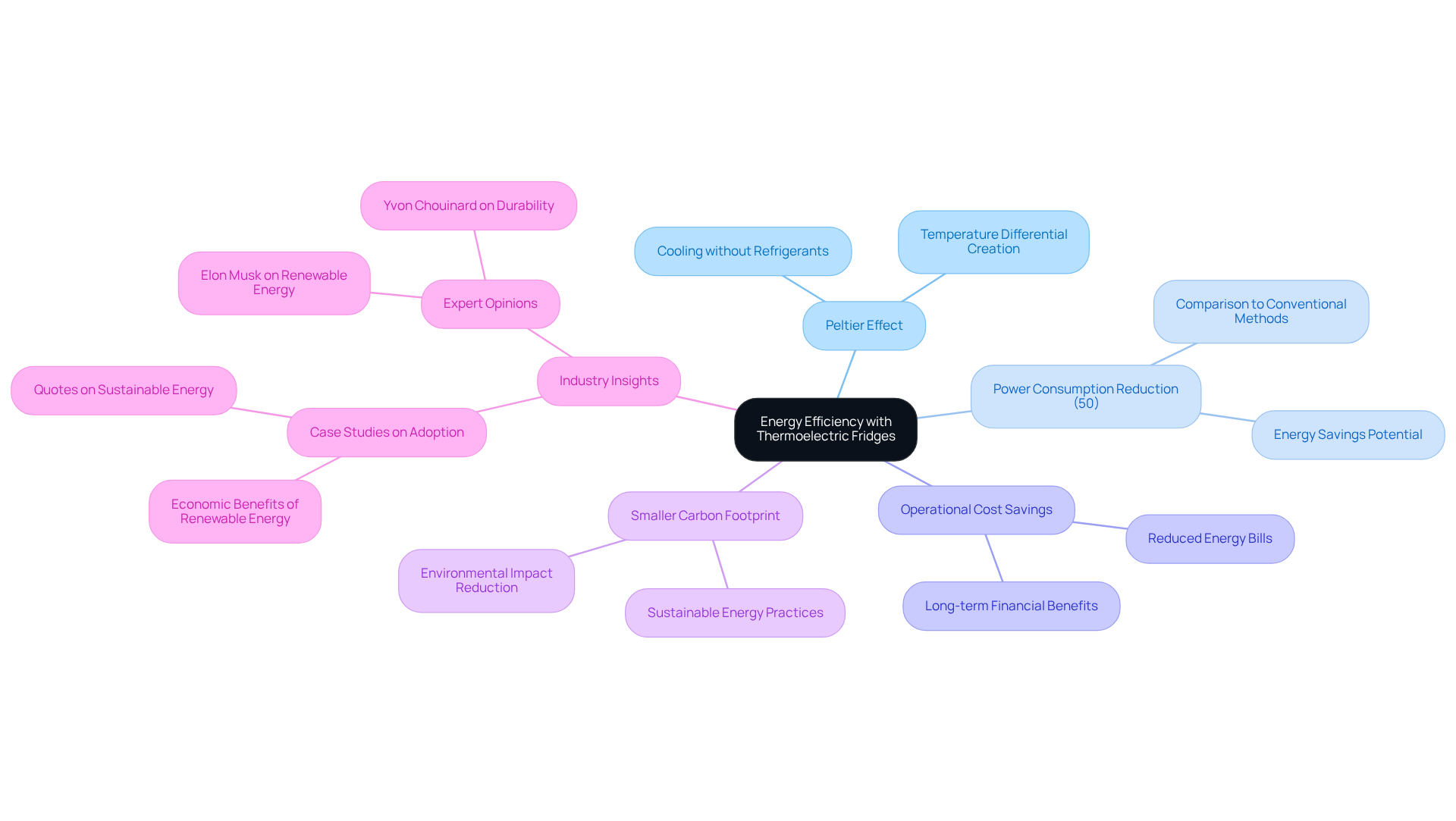
Compact Design: The Space-Saving Advantage of Thermoelectric Fridges
Thermoelectric fridges stand out because of their compact design, which distinguishes them from traditional refrigerators that use bulky compressors and extensive piping. These lightweight units, including the thermoelectric fridge, can be seamlessly integrated into various applications, enabling engineers to optimize the use of available space in their designs. This space-saving feature is particularly advantageous for portable devices and compact setups, positioning thermoelectric fridge systems as optimal solutions for contemporary engineering challenges.
Significantly, Gagner-Toomey Associates, the world’s largest producer of standard and custom air-movers for temperature regulation, offers an extensive range of thermal management solutions, featuring advanced cooling devices. The market for Peltier coolers was valued at $569.0 million in 2020 and is projected to expand considerably, with a compound annual growth rate (CAGR) of 8.7% from 2021 to 2030. This growth underscores the rising demand for , particularly within the consumer electronics segment, which holds the largest market share.
Moreover, the advancement of thermoelectric fridges for new applications is expected to generate further growth opportunities, enhancing their value in space-limited settings. However, it is crucial to acknowledge that high costs compared to traditional systems remain a significant constraint. Additionally, the stability and low vibration of thermoelectric coolers further enhance their appeal in engineering applications.
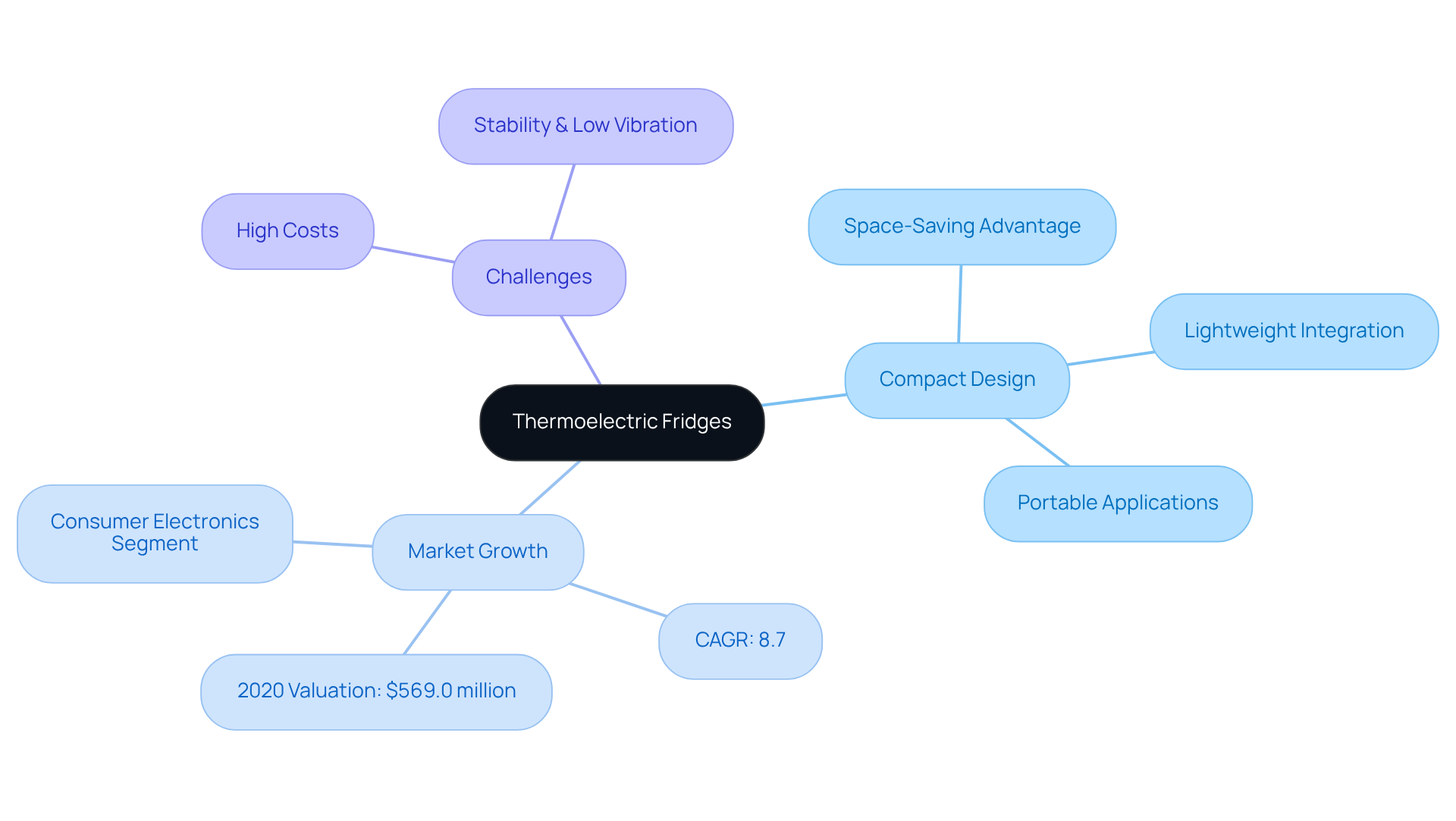
Versatility: Applications of Thermoelectric Fridges in Diverse Environments
Thermoelectric fridges showcase remarkable versatility, being applicable in a wide range of environments, including automotive and medical devices. Their capacity to operate efficiently under diverse conditions makes them ideal for use in remote locations, portable coolers, and as a thermoelectric fridge in laboratory settings. This adaptability not only enhances product functionality but also addresses specific across various sectors, empowering engineers to leverage this technology effectively.

Low Maintenance: The Convenience of Thermoelectric Fridges
Thermoelectric fridges are distinguished by their minimal maintenance requirements when compared to conventional refrigeration units. Lacking moving parts and refrigerants, the thermoelectric fridge units substantially diminish the risk of mechanical failure. This inherent reliability leads to a notable decrease in downtime; research indicates that thermal management solutions can reduce operational interruptions by as much as 30%.
Furthermore, the market for cooling devices employing thermoelectric principles was valued at USD 757.2 million in 2025, with projections suggesting growth to USD 1,318 million by 2035. This trend underscores the increasing across various sectors.
Engineers seeking dependable temperature control options find thermoelectric fridges particularly appealing, as these devices not only lower operational costs but also enhance overall efficiency. Nonetheless, competition from traditional refrigeration technologies poses a challenge.
Advancements in heat-exchange materials are further bolstering the reliability and efficiency of thermoelectric fridges. Consequently, temperature-regulating systems are increasingly recognized as a preferred choice for applications demanding consistent performance. Engineers are thus encouraged to explore these innovative solutions for their cooling needs.
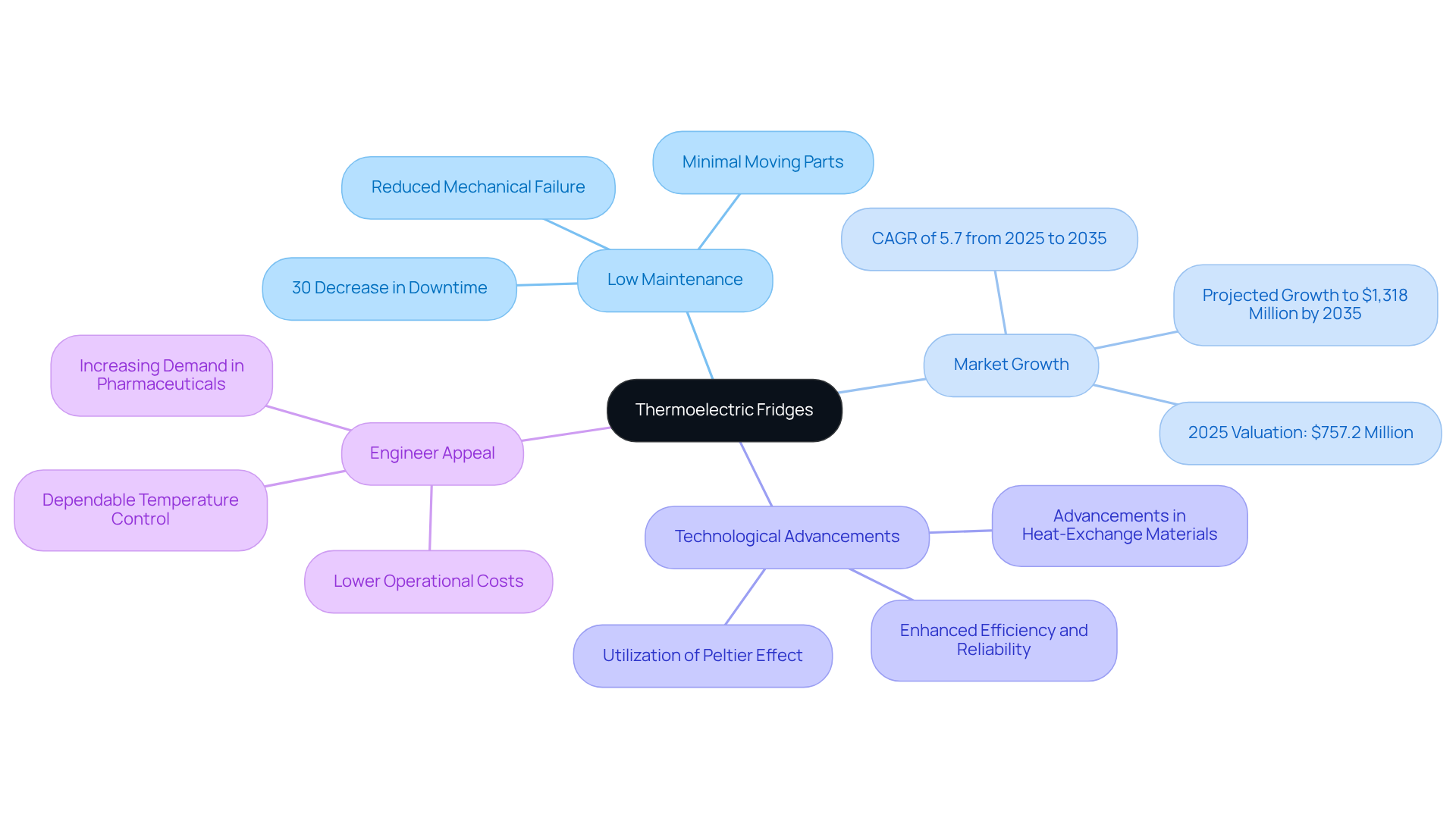
Quiet Operation: Enjoying Peaceful Cooling with Thermoelectric Fridges
One of the most compelling features of these refrigerators is their silent operation. In contrast to traditional models, which can generate significant noise from compressors and fans, thermoelectric units function without sound. This characteristic proves particularly advantageous in settings where is paramount, such as homes, offices, or laboratories. Consequently, engineers are empowered to design products that deliver efficient temperature regulation while preserving the tranquility of the surrounding environment.

Eco-Friendliness: The Sustainable Choice of Thermoelectric Fridges
A compelling eco-friendly alternative to conventional refrigeration systems is represented by thermoelectric fridges. Unlike traditional models, they do not rely on that contribute to ozone depletion and global warming. By leveraging solid-state technology, the thermoelectric fridge not only minimizes environmental impact but also provides efficient temperature control.
Engineers have a unique opportunity to promote sustainability in their designs by integrating thermoelectric fridge solutions. This aligns seamlessly with global initiatives aimed at reducing carbon footprints and enhancing ecological responsibility.
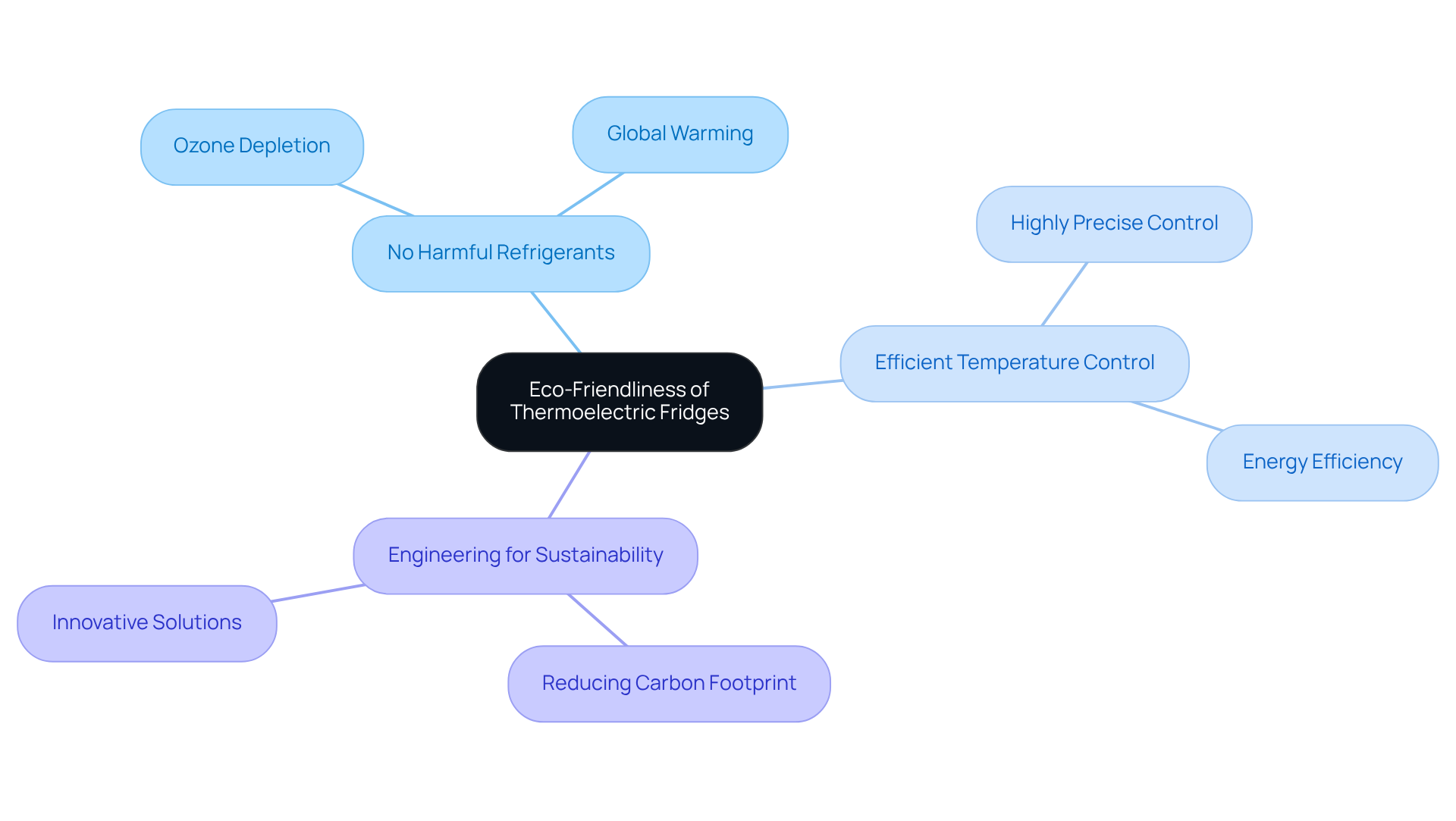
Advanced Technology: The Cutting-Edge Features of Thermoelectric Fridges
Thermoelectric fridges showcase features that represent a significant advancement in temperature regulation technology, markedly improving performance and efficiency. Digital temperature control stands out as a key innovation, enabling precise adjustments, while smart sensors actively monitor environmental conditions in real-time. These sensors facilitate energy monitoring frameworks, empowering users to optimize energy usage based on actual temperature needs.
As a result, engineers are able to develop more intelligent and efficient products that seamlessly adapt to varying temperature requirements, ultimately boosting overall performance. The growing integration of smart sensors in temperature regulation systems is indicative of a broader movement towards energy efficiency and sustainability.
Notably, the thermally driven refrigerator market is projected to reach USD 1,318 million by 2035, following a historical growth rate of 4.9% from 2020 to 2024. North America emerges as a prominent market for energy-efficient refrigerators, propelled by consumer demand for portable cooling solutions. This trend highlights the critical importance of with environmental responsibility.
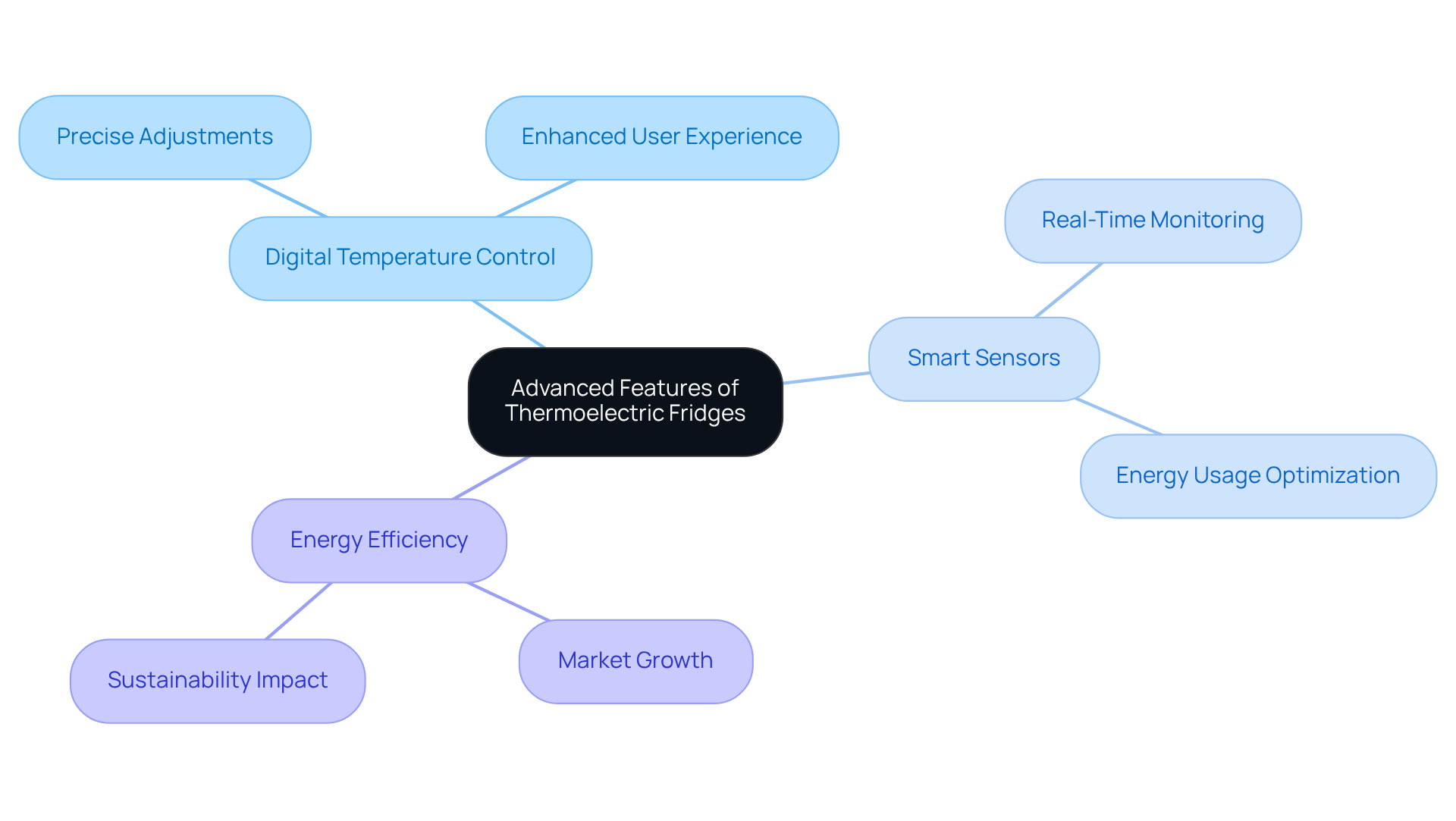
Cost-Effectiveness: Long-Term Savings with Thermoelectric Fridges
Investing in a thermoelectric fridge may entail a higher initial expense compared to conventional refrigeration options; however, the long-term savings are substantial. These systems are designed to minimize energy usage, leading to significant reductions in operating expenses over time. For instance, the Department of Energy estimates that the proposed energy conservation standards could save approximately 4.48 quads of cumulative energy over 30 years, which is equivalent to three times the total energy consumed annually for refrigeration and freezers in U.S. homes. This translates into considerable , with annualized benefits projected at $2,112 million per year in reduced operating costs at a 7% discount rate. Additionally, cooling systems typically incur lower maintenance expenses due to their simpler design and fewer moving components, thereby enhancing their reliability and lifespan.
Financial analysts have observed that the net present value of emissions reductions from these systems can range between $1.04 billion and $16.22 billion, highlighting the economic advantages of adopting energy-efficient technologies. As the demand for energy-saving solutions continues to grow, engineers can leverage these financial benefits to advocate for alternative options in cost-conscious projects. By presenting a compelling case that emphasizes reduced energy consumption, lower maintenance costs, and improved reliability, the thermoelectric fridge stands out as an attractive choice for engineers aiming to optimize project budgets while contributing to sustainability objectives.
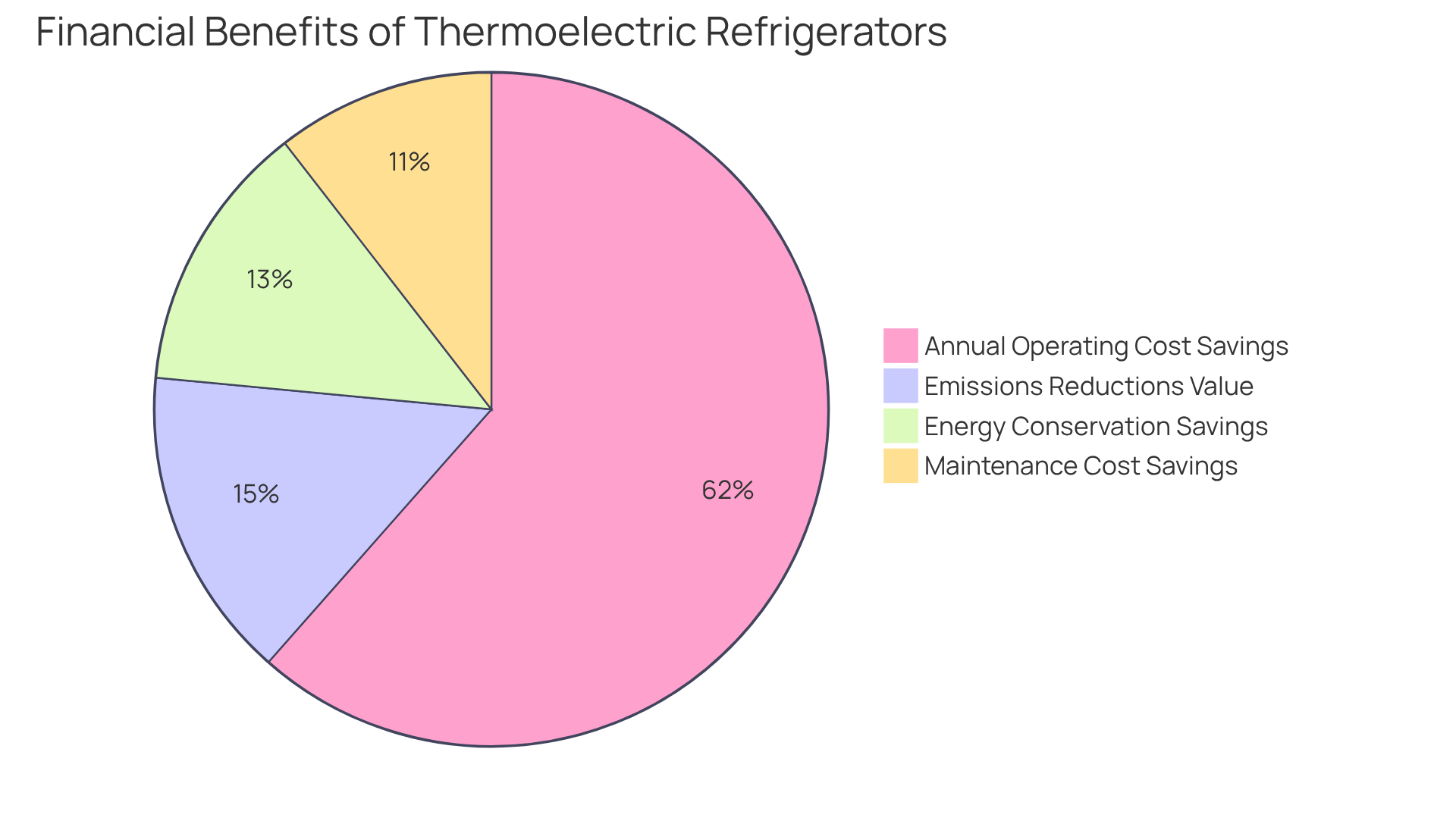
Market Demand: The Rising Popularity of Thermoelectric Fridges
The demand for thermoelectric fridges is surging as industries increasingly acknowledge their advantages. The thermoelectric fridge is gaining traction in sectors such as consumer electronics, automotive, and medical applications, driven by its efficiency and versatility.
Significantly, the global market for cooling devices is anticipated to attain around $794.38 million in 2025, with projections to expand to $1.83 billion at a CAGR of 8.7% from 2025 to 2035. This growth indicates a notable change in consumer demand for , including the thermoelectric fridge, that enhance performance while reducing energy usage.
Engineers can capitalize on this trend by incorporating temperature-driven technologies into their designs, ensuring they align with market needs and maintain a competitive edge.
Gagner-Toomey Associates (GTA) plays a crucial role in this environment, offering innovative sales strategies and professional assistance to engineers across various sectors, including Telecom, Automotive, and Medical.
Key participants in the sector, such as Ferrotec Corporation, Applied Thermoelectric Solutions LLC, and Adcol Electronics, are concentrating on specialized applications, further strengthening the importance of thermoelectric fridges in contemporary engineering methods.
As Joseph Dir, Global Sales & Marketing at Delta Products Corp, states, “Using IT tools for opportunity tracking, funnel management, and sales reporting are fundamental to our achievement of consistent, ongoing growth,” highlighting the importance of advanced IT solutions in driving innovation and customer satisfaction.
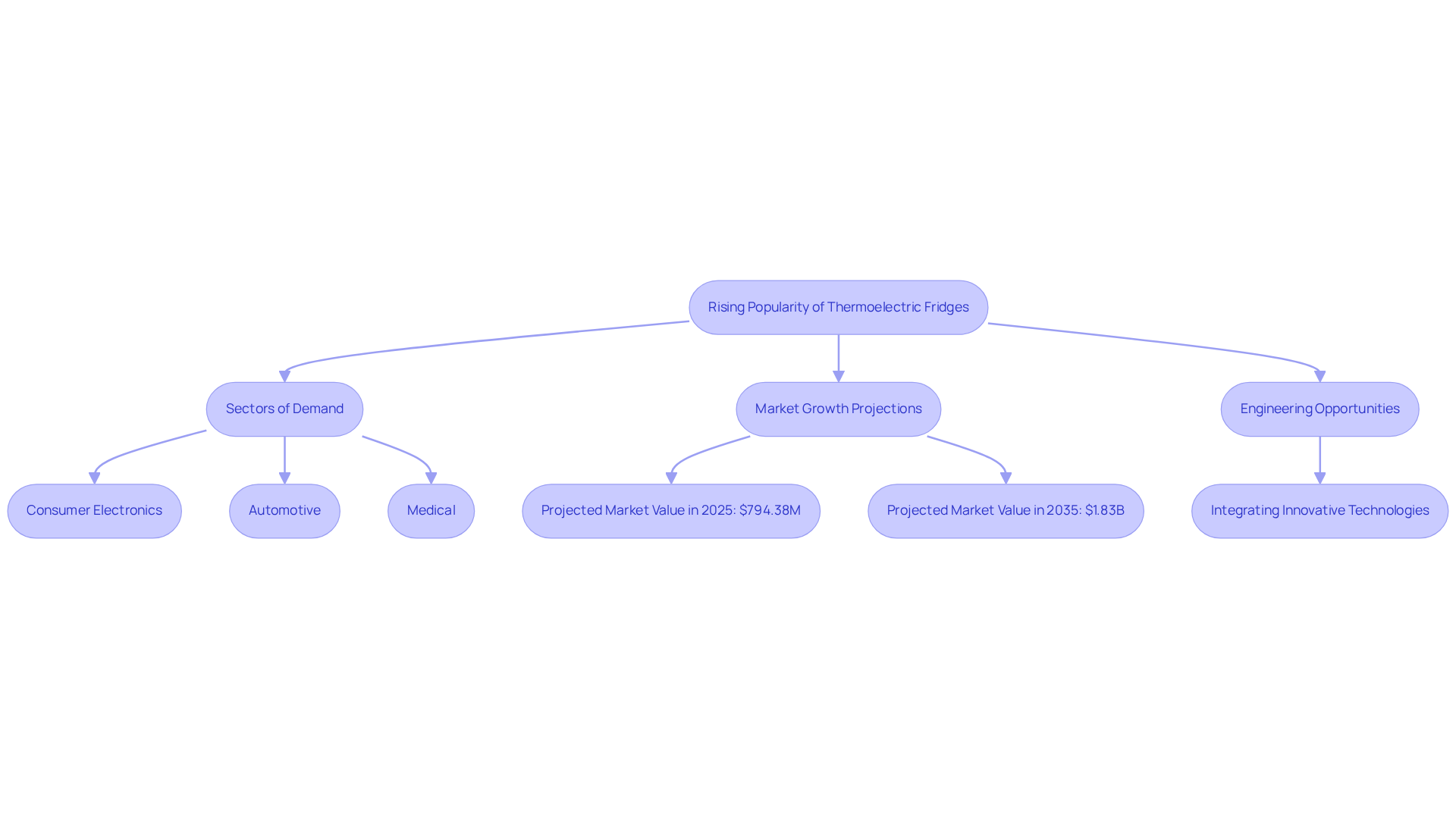
Conclusion
Thermoelectric fridges signify a transformative leap in refrigeration technology, offering engineers a multitude of benefits that align with contemporary demands for efficiency, sustainability, and compact design. By harnessing the Peltier effect, these cooling systems not only reduce energy consumption but also deliver reliable temperature control without the mechanical complexities associated with traditional refrigerators. This innovation positions thermoelectric fridges as a pivotal solution for engineers aiming to enhance their designs while adhering to eco-friendly practices.
Throughout this discussion, key advantages of thermoelectric fridges have been underscored, including:
- Low maintenance requirements
- Quiet operation
- Versatility across diverse applications
The compact design facilitates seamless integration into space-constrained environments, while the advanced technology inherent in these units promotes energy efficiency and operational savings. Moreover, the burgeoning market demand for such innovative cooling solutions highlights the critical role of thermoelectric technology in modern engineering practices.
In conclusion, the adoption of thermoelectric fridges is not merely a trend; it represents a necessary step toward a more sustainable future in engineering. As industries increasingly prioritize energy-efficient solutions, engineers are urged to explore the potential of thermoelectric cooling systems in their projects. Embracing these advancements can yield significant long-term savings, diminish environmental impact, and enhance product performance, ultimately contributing to a greener and more efficient world.
Frequently Asked Questions
What is Gagner-Toomey Associates known for?
Gagner-Toomey Associates is known for pioneering innovative temperature control solutions, particularly in thermoelectric fridge technology, and providing engineers with advanced temperature management solutions.
What are the benefits of thermoelectric fridges?
Thermoelectric fridges offer a compact design, reliability, and the ability to function without moving parts, resulting in reduced maintenance requirements and extended lifespans. They are particularly useful in applications requiring precise temperature regulation.
How do thermoelectric fridges contribute to energy efficiency?
Thermoelectric fridges leverage the Peltier effect to create a temperature differential without traditional refrigerants, potentially reducing power consumption by up to 50% compared to conventional refrigeration methods.
What industries have successfully implemented thermoelectric cooling technologies?
Various industries have successfully implemented thermoelectric cooling technologies, particularly in the electronics sector, where there is a growing acceptance of energy-efficient refrigerators.
How does the compact design of thermoelectric fridges benefit engineers?
The compact design of thermoelectric fridges allows for seamless integration into various applications, optimizing space usage in designs, which is especially beneficial for portable devices and compact setups.
What is the projected market growth for Peltier coolers?
The market for Peltier coolers was valued at $569.0 million in 2020 and is projected to grow at a compound annual growth rate (CAGR) of 8.7% from 2021 to 2030.
What challenges do thermoelectric fridges face in the market?
Thermoelectric fridges face challenges such as higher costs compared to traditional refrigeration systems, despite their advantages in stability and low vibration.

